Paper Menu >>
Journal Menu >>
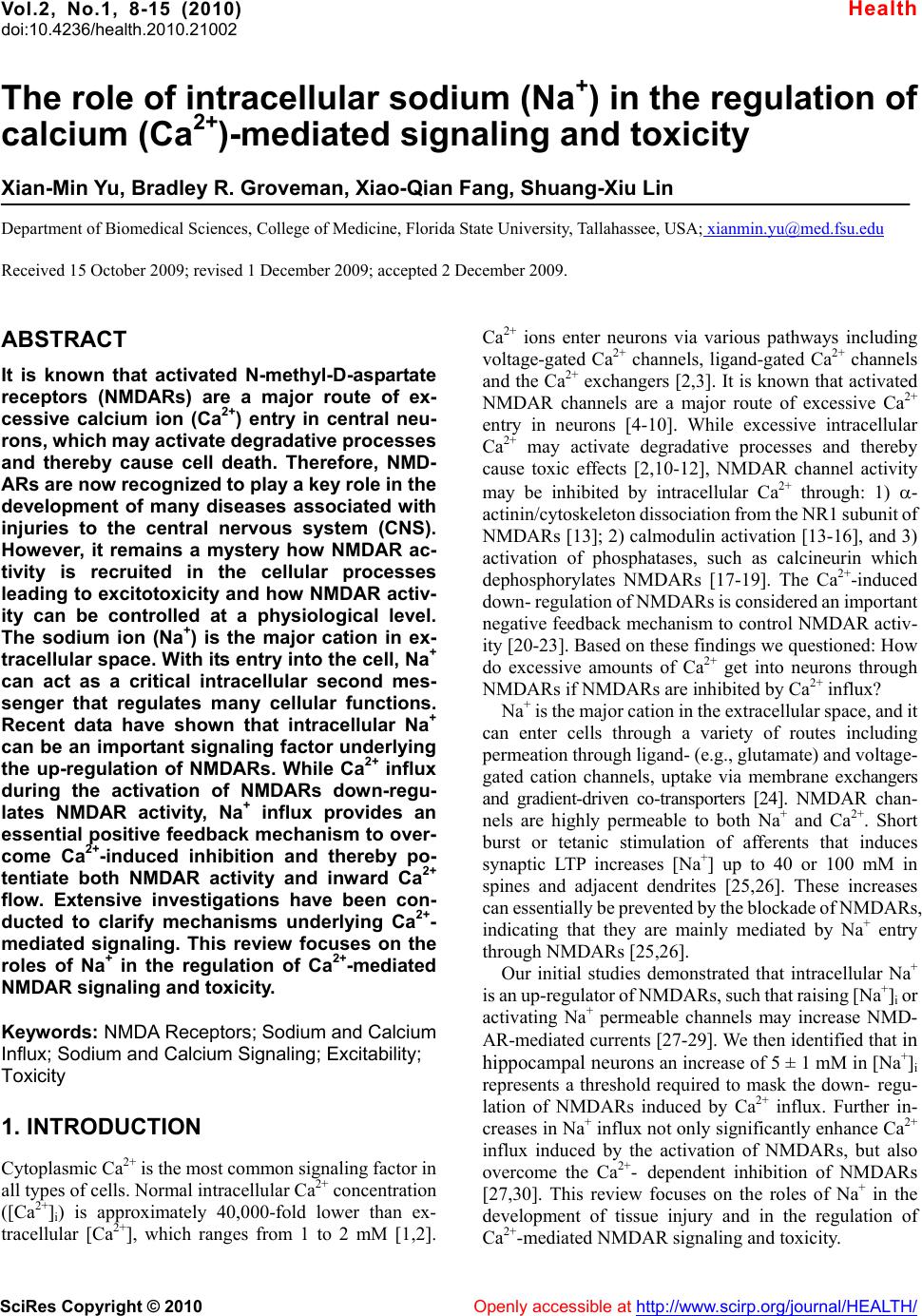 Vol.2, No.1, 8-15 (2010) doi:10.4236/health.2010.21002 SciRes Copyright © 2010 Openly accessible at http://www.scirp.org/journal/HEALTH/ Health The role of intracellular sodium (Na+) in the regulation of calcium (Ca2+)-mediated signaling and toxicity Xian-Min Yu, Bradley R. Groveman, Xiao-Qian Fang, Shuang-Xiu Lin Department of Biomedical Sciences, College of Medicine, Florida State University, Tallahassee, USA; xianmin.yu@med.fsu.edu Received 15 October 2009; revised 1 December 2009; accepted 2 December 2009. ABSTRACT It is known that activated N-methyl-D-aspartate receptors (NMDARs) are a major route of ex- cessive calcium ion (Ca2+) entry in central neu- rons, which may activate degradative processes and thereby cause cell death. Therefore, NMD- ARs are now recognized to play a key role in the development of many diseases associated with injuries to the central nervous system (CNS). However, it remains a mystery how NMDAR ac- tivity is recruited in the cellular processes leading to excitotoxicity and how NMDAR activ- ity can be controlled at a physiological level. The sodium ion (Na+) is the major cation in ex- tracellular space. With its entry into the cell, Na+ can act as a critical intracellular second mes- senger that regulates many cellular functions. Recent data have shown that intracellular Na+ can be an important signaling factor underlying the up-regulation of NMDARs. While Ca2+ influx during the activation of NMDARs down-regu- lates NMDAR activity, Na+ influx provides an essential positive feedback mechanism to over- come Ca2+-induced inhibition and thereby po- tentiate both NMDAR activity and inward Ca2+ flow. Extensive investigations have been con- ducted to clarify mechanisms underlying Ca2+- mediated signaling. This review focuses on the roles of Na+ in the regulation of Ca2+-mediated NMDAR signaling and toxicity. Keywords: NMDA Receptors; Sodium and Calcium Influx; Sodium and Calcium Signaling; Excitability; Toxicity 1. INTRODUCTION Cytoplasmic Ca2+ is the most common signaling factor in all types of cells. Normal intracellular Ca2+ concentration ([Ca2+]i) is approximately 40,000-fold lower than ex- tracellular [Ca2+], which ranges from 1 to 2 mM [1,2]. Ca2+ ions enter neurons via various pathways including voltage-gated Ca2+ channels, ligand-gated Ca2+ channels and the Ca2+ exchangers [2,3]. It is known that activated NMDAR channels are a major route of excessive Ca2+ entry in neurons [4-10]. While excessive intracellular Ca2+ may activate degradative processes and thereby cause toxic effects [2,10-12], NMDAR channel activity may be inhibited by intracellular Ca2+ through: 1) - actinin/cytoskeleton dissociation from the NR1 subunit of NMDARs [13]; 2) calmodulin activation [13-16], and 3) activation of phosphatases, such as calcineurin which dephosphorylates NMDARs [17-19]. The Ca2+-induced down- regulation of NMDARs is considered an important negative feedback mechanism to control NMDAR activ- ity [20-23]. Based on these findings we questioned: How do excessive amounts of Ca2+ get into neurons through NMDARs if NMDARs are inhibited by Ca2+ influx? Na+ is the major cation in the extracellular space, and it can enter cells through a variety of routes including permeation through ligand- (e.g., glutamate) and voltage- gated cation channels, uptake via membrane exchangers and gradient-driven co-transporters [24]. NMDAR chan- nels are highly permeable to both Na+ and Ca2+. Short burst or tetanic stimulation of afferents that induces synaptic LTP increases [Na+] up to 40 or 100 mM in spines and adjacent dendrites [25,26]. These increases can essentially be prevented by the blockade of NMDARs, indicating that they are mainly mediated by Na+ entry through NMDARs [25,26]. Our initial studies demonstrated that intracellular Na+ is an up-regulator of NMDARs, such that raising [Na+]i or activating Na+ permeable channels may increase NMD- AR-mediated currents [27-29]. We then identified that in hippocampal neurons an increase of 5 ± 1 mM in [Na+]i represents a threshold required to mask the down- regu- lation of NMDARs induced by Ca2+ influx. Further in- creases in Na+ influx not only significantly enhance Ca2+ influx induced by the activation of NMDARs, but also overcome the Ca2+- dependent inhibition of NMDARs [27,30]. This review focuses on the roles of Na+ in the development of tissue injury and in the regulation of Ca2+-mediated NMDAR signaling and toxicity. 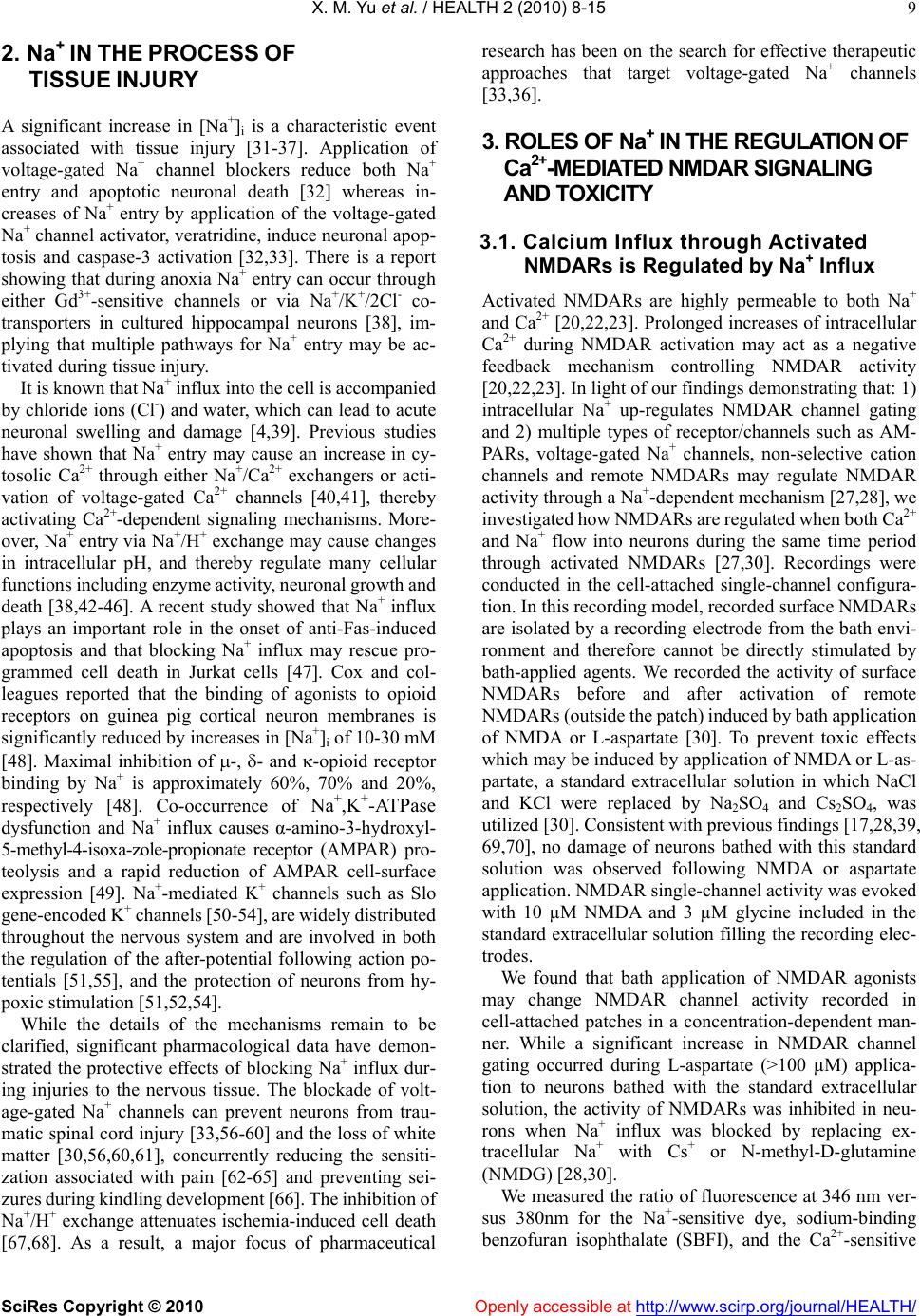 X. M. Yu et al. / HEALTH 2 (2010) 8-15 SciRes Copyright © 2010 Openly accessible at http://www.scirp.org/journal/HEALTH/ 9 2. Na+ IN THE PROCESS OF TISSUE INJURY A significant increase in [Na+]i is a characteristic event associated with tissue injury [31-37]. Application of voltage-gated Na+ channel blockers reduce both Na+ entry and apoptotic neuronal death [32] whereas in- creases of Na+ entry by application of the voltage-gated Na+ channel activator, veratridine, induce neuronal apop- tosis and caspase-3 activation [32,33]. There is a report showing that during anoxia Na+ entry can occur through either Gd3+-sensitive channels or via Na+/K+/2Cl- co- transporters in cultured hippocampal neurons [38], im- plying that multiple pathways for Na+ entry may be ac- tivated during tissue injury. It is known that Na+ influx into the cell is accompanied by chloride ions (Cl-) and water, which can lead to acute neuronal swelling and damage [4,39]. Previous studies have shown that Na+ entry may cause an increase in cy- tosolic Ca2+ through either Na+/Ca2+ exchangers or acti- vation of voltage-gated Ca2+ channels [40,41], thereby activating Ca2+-dependent signaling mechanisms. More- over, Na+ entry via Na+/H+ exchange may cause changes in intracellular pH, and thereby regulate many cellular functions including enzyme activity, neuronal growth and death [38,42-46]. A recent study showed that Na+ influx plays an important role in the onset of anti-Fas-induced apoptosis and that blocking Na+ influx may rescue pro- grammed cell death in Jurkat cells [47]. Cox and col- leagues reported that the binding of agonists to opioid receptors on guinea pig cortical neuron membranes is significantly reduced by increases in [Na+]i of 10-30 mM [48]. Maximal inhibition of -, - and -opioid receptor binding by Na+ is approximately 60%, 70% and 20%, respectively [48]. Co-occurrence of Na+,K+-ATPase dysfunction and Na+ influx causes α-amino-3-hydroxyl- 5-methyl-4-isoxa-zole-propionate receptor (AMPAR) pro- teolysis and a rapid reduction of AMPAR cell-surface expression [49]. Na+-mediated K+ channels such as Slo gene-encoded K+ channels [50-54], are widely distributed throughout the nervous system and are involved in both the regulation of the after-potential following action po- tentials [51,55], and the protection of neurons from hy- poxic stimulation [51,52,54]. While the details of the mechanisms remain to be clarified, significant pharmacological data have demon- strated the protective effects of blocking Na+ influx dur- ing injuries to the nervous tissue. The blockade of volt- age-gated Na+ channels can prevent neurons from trau- matic spinal cord injury [33,56-60] and the loss of white matter [30,56,60,61], concurrently reducing the sensiti- zation associated with pain [62-65] and preventing sei- zures during kindling development [66]. The inhibition of Na+/H+ exchange attenuates ischemia-induced cell death [67,68]. As a result, a major focus of pharmaceutical research has been on the search for effective therapeutic approaches that target voltage-gated Na+ channels [33,36]. 3. ROLES OF Na+ IN THE REGULATION OF Ca2+-MEDIATED NMDAR SIGNALING AND TOXICITY 3.1. Calcium Influx through Activated NMDARs is Regulated by Na+ Influx Activated NMDARs are highly permeable to both Na+ and Ca2+ [20,22,23]. Prolonged increases of intracellular Ca2+ during NMDAR activation may act as a negative feedback mechanism controlling NMDAR activity [20,22,23]. In light of our findings demonstrating that: 1) intracellular Na+ up-regulates NMDAR channel gating and 2) multiple types of receptor/channels such as AM- PARs, voltage-gated Na+ channels, non-selective cation channels and remote NMDARs may regulate NMDAR activity through a Na+-dependent mechanism [27,28], we investigated how NMDARs are regulated when both Ca2+ and Na+ flow into neurons during the same time period through activated NMDARs [27,30]. Recordings were conducted in the cell-attached single-channel configura- tion. In this recording model, recorded surface NMDARs are isolated by a recording electrode from the bath envi- ronment and therefore cannot be directly stimulated by bath-applied agents. We recorded the activity of surface NMDARs before and after activation of remote NMDARs (outside the patch) induced by bath application of NMDA or L-aspartate [30]. To prevent toxic effects which may be induced by application of NMDA or L-as- partate, a standard extracellular solution in which NaCl and KCl were replaced by Na2SO4 and Cs2SO4, was utilized [30]. Consistent with previous findings [17,28,39, 69,70], no damage of neurons bathed with this standard solution was observed following NMDA or aspartate application. NMDAR single-channel activity was evoked with 10 µM NMDA and 3 µM glycine included in the standard extracellular solution filling the recording elec- trodes. We found that bath application of NMDAR agonists may change NMDAR channel activity recorded in cell-attached patches in a concentration-dependent man- ner. While a significant increase in NMDAR channel gating occurred during L-aspartate (>100 µM) applica- tion to neurons bathed with the standard extracellular solution, the activity of NMDARs was inhibited in neu- rons when Na+ influx was blocked by replacing ex- tracellular Na+ with Cs+ or N-methyl-D-glutamine (NMDG) [28,30]. We measured the ratio of fluorescence at 346 nm ver- sus 380nm for the Na+-sensitive dye, sodium-binding benzofuran isophthalate (SBFI), and the Ca2+-sensitive  X. M. Yu et al. / HEALTH 2 (2010) 8-15 SciRes Copyright © 2010 Openly accessible at http://www.scirp.org/journal/HEALTH/ 10 dye, Fura-2, in the soma region of neurons. When the Na+ gradient across the cell membrane was decreased by reducing extracellular Na+ concentration ([Na+]e) to 20 mM and the Na+ ionophore, monensin (10 M) was in- cluded in the extracellular solution, basal [Ca2+]i and [Na+]i of neurons were approximately 84 nM and 16 mM, respectively. Under this condition bath application of L-aspartate increased [Ca2+]i by 66 nM, decreased [Na+]i by 5.8 mM and inhibited NMDAR activity [30]. On av- erage, the overall channel open probability and mean open time were reduced to 64% and 77% of controls. The burst and cluster lengths were also significantly reduced. These inhibitory effects produced by the bath application of L-aspartate were prevented by either application of APV or removal of Ca2+ from extracellular solution, indicating that the activation of remote NMDARs may also down-regulate recorded NMDAR activity through Ca2+ influx [30]. Thus, it is demonstrated that NMDARs can be up- and down-regulated by influxes of Na+ and Ca2+, respectively. We then measured changes of [Na+]i and [Ca2+]i in neurons bathed with extracellular solution containing a [Na+] of 10, 20 or 145 mM before and during the activa- tion of NMDARs induced by bath application of L-aspartate. We found that with an increase in [Na+]e, the activation NMDARs produced increases in [Na+]i as ex- pected, but also increased [Ca2+]i. Excluding the effect of Ca2+ influx-induced Ca2+ release (CICR) from intracel- lular stores, the increase in [Ca2+]i of neurons bathed with extracellular solution containing 145 mM Na+ was still significantly higher than that found in neurons bathed with extracellular solution containing 10 mM Na+ [28,30 ]. When [Na+]e was reduced to 10 mM, the activation of NMDARs produced increases in [Na]i and [Ca2+]i by around 0.8 mM and 35 nM, respectively. Under this condition, the activation of remote NMDARs inhibited NMDAR activity recorded in cell-attached patches [30]. When [Na+]e was increased to 20 mM, NMDAR activa- tion produced a 5 mM increase in [Na+]i and a 50 nM increase in [Ca2+]i, but no change in the activity of re- corded NMDARs [30]. Similarly, increasing [K+]e by 30 mM in an extracellular solution containing 170 mM Na+ and 1 M TTX produced increases in [Na+]i and [Ca2+]i by around 7 mM and 48 nM, respectively, but again showed no change in the activity of NMDARs recorded in cell-attached patches either [28,30 ]. Thus, an increase in [Na+]i of approximately 5 mM appeared to be a critical concentration for masking the inhibitory effects induced by Ca2+ influx on NMDARs in cultured hippocampal neurons [30]. Since a modest increase of [Ca2+]i by ap- proximately 35 nM inhibited NMDAR activity when [Na+]e was reduced to 10 mM [30], it was possible that Na+ influx not only enhanced Ca2+ influx but also masked the inhibitory effects of Ca2+. To confirm this hypothesis, we recorded NMDAR single-channel activity before and during the activation of remote NMDARs in cell-attached patches with pipettes filled with a Ca2+-free extracellular solution containing 200 mM Na+ from neurons that had been pre-treated with BAPTA-AM (10 M for 4 hrs) and bathed with the same Ca2+-free extracellular solution, or with pipettes filled with extracellular solution containing 0.3 or 1.2 mM Ca2+ from neurons bathed with the extracellular solution con- taining the same amount of Ca2+, respectively. We found that the activation of remote NMDARs produced a simi- lar up-regulation of NMDAR channel activity when local and bath [Ca2+] was set at 0, 0.3 and 1.2 mM, implying again that the effects of Ca2+ influx in the regulation of NMDARs by remote NMDARs are overcome by Na+ under normal condition [30]. Furthermore, removal of extracellular Ca2+ did not produce any effect on the up-regulation of NMDARs by remote NMDARs in neu- rons bathed with the standard extracellular solution con- taining 200 mM Na+ [28,30]. Thus, we conclude that Ca2+ influx through activated NMDARs is regulated by Na+ influx, and that the effect of Na+, which overcomes Ca2+-induced inhibition, provides an essential positive feedback mechanism enhancing both the NMDAR activ- ity and the inward flow of Ca2+. 3.2. Depletion of Extracellular Ca2+ Enhances Na+ Influx and Thereby Causes NMDAR-Mediated Toxicity Based on the findings that glutamate concentration may increase in both humans [71,72] and animals after nervous system injury [73], and that application of NMDAR an- tagonists may protect neurons from excitotoxic injuries in both humans [74,75] and animal [39,74,76], it has been believed that NMDAR-mediated excitoxicity plays a ke- y role in the development of neuronal death associated with stroke/traumatic CNS injury. However, it remained unclear how NMDARs were recruited to cause neurotoxicity. We examined the effects of extracellular Ca2+ depletion and reperfusion, which may occur in stroke patients, on cultured hippocampal neurons [27,77]. Neurons were bathed initially with an extracellular solution containing: 140 mM NaCl, 5 mM CsCl, 1.8 mM CaCl2, 33 mM glucose, 25 mM HEPES; pH: 7.35; osmolarity: 310-320 mOsm. The reduction of [Ca2+]e from 1.8 mM to 0.5 or 0 mM caused a significant increase in Caspase-3 activity and morphological changes in neurons such as swelling, beading, and/or process disintegration. Significantly less formazan was observed in 3-(4,5-dimethylthiazol-2-yl) 2,5-diphenyl-tetrazolium bromide (MTT) assays in which neurons were treated with the extracellular solution con- taining 0.5 or 0 mM Ca2+, indicating a change in mito- chondrial function associated with neuronal injury [78-81]. Unexpectedly, application of NMDAR antago- nists APV (100 M) and MK801 (2 M) significantly prevented the above mentioned changes in neurons only 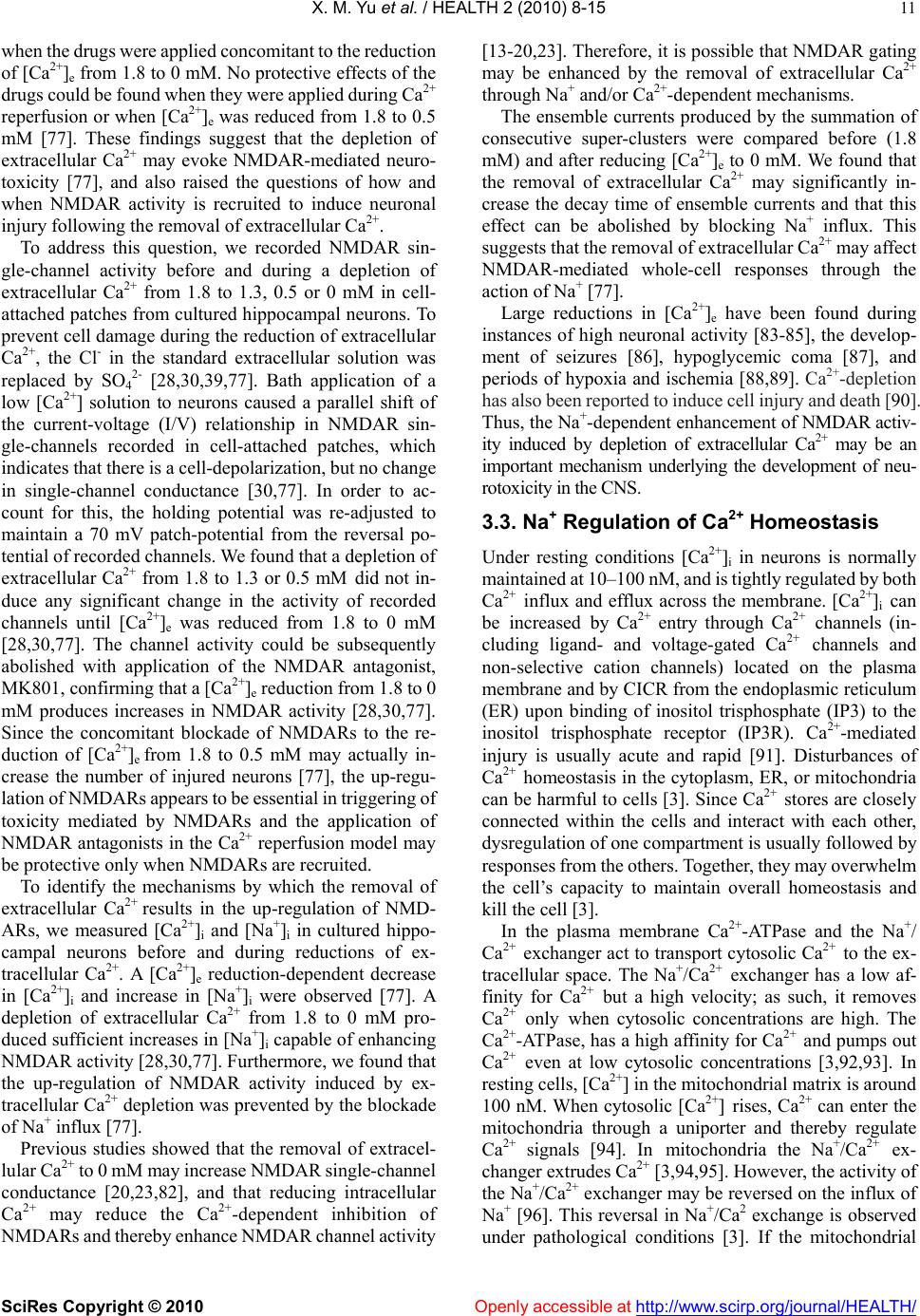 X. M. Yu et al. / HEALTH 2 (2010) 8-15 SciRes Copyright © 2010 Openly accessible at http://www.scirp.org/journal/HEALTH/ 11 when the drugs were applied concomitant to the reduction of [Ca2+]e from 1.8 to 0 mM. No protective effects of the drugs could be found when they were applied during Ca2+ reperfusion or when [Ca2+]e was reduced from 1.8 to 0.5 mM [77]. These findings suggest that the depletion of extracellular Ca2+ may evoke NMDAR-mediated neuro- toxicity [77], and also raised the questions of how and when NMDAR activity is recruited to induce neuronal injury following the removal of extracellular Ca2+. To address this question, we recorded NMDAR sin- gle-channel activity before and during a depletion of extracellular Ca2+ from 1.8 to 1.3, 0.5 or 0 mM in cell- attached patches from cultured hippocampal neurons. To prevent cell damage during the reduction of extracellular Ca2+, the Cl- in the standard extracellular solution was replaced by SO4 2- [28,30,39,77]. Bath application of a low [Ca2+] solution to neurons caused a parallel shift of the current-voltage (I/V) relationship in NMDAR sin- gle-channels recorded in cell-attached patches, which indicates that there is a cell-depolarization, but no change in single-channel conductance [30,77]. In order to ac- count for this, the holding potential was re-adjusted to maintain a 70 mV patch-potential from the reversal po- tential of recorded channels. We found that a depletion of extracellular Ca2+ from 1.8 to 1.3 or 0.5 mM did not in- duce any significant change in the activity of recorded channels until [Ca2+]e was reduced from 1.8 to 0 mM [28,30,77]. The channel activity could be subsequently abolished with application of the NMDAR antagonist, MK801, confirming that a [Ca2+]e reduction from 1.8 to 0 mM produces increases in NMDAR activity [28,30,77]. Since the concomitant blockade of NMDARs to the re- duction of [Ca2+]e from 1.8 to 0.5 mM may actually in- crease the number of injured neurons [77], the up-regu- lation of NMDARs appears to be essential in triggering of toxicity mediated by NMDARs and the application of NMDAR antagonists in the Ca2+ reperfusion model may be protective only when NMDARs are recruited. To identify the mechanisms by which the removal of extracellular Ca2+ results in the up-regulation of NMD- ARs, we measured [Ca2+]i and [Na+]i in cultured hippo- campal neurons before and during reductions of ex- tracellular Ca2+. A [Ca2+]e reduction-dependent decrease in [Ca2+]i and increase in [Na+]i were observed [77]. A depletion of extracellular Ca2+ from 1.8 to 0 mM pro- duced sufficient increases in [Na+]i capable of enhancing NMDAR activity [28,30,77]. Furthermore, we found that the up-regulation of NMDAR activity induced by ex- tracellular Ca2+ depletion was prevented by the blockade of Na+ influx [77]. Previous studies showed that the removal of extracel- lular Ca2+ to 0 mM may increase NMDAR single-channel conductance [20,23,82], and that reducing intracellular Ca2+ may reduce the Ca2+-dependent inhibition of NMDARs and thereby enhance NMDAR channel activity [13-20,23]. Therefore, it is possible that NMDAR gating may be enhanced by the removal of extracellular Ca2+ through Na+ and/or Ca2+-dependent mechanisms. The ensemble currents produced by the summation of consecutive super-clusters were compared before (1.8 mM) and after reducing [Ca2+]e to 0 mM. We found that the removal of extracellular Ca2+ may significantly in- crease the decay time of ensemble currents and that this effect can be abolished by blocking Na+ influx. This suggests that the removal of extracellular Ca2+ may affect NMDAR-mediated whole-cell responses through the action of Na+ [77]. Large reductions in [Ca2+]e have been found during instances of high neuronal activity [83-85], the develop- ment of seizures [86], hypoglycemic coma [87], and periods of hypoxia and ischemia [88,89]. Ca2+-depletion has also been reported to induce cell injury and death [90]. Thus, the Na+-dependent enhancement of NMDAR activ- ity induced by depletion of extracellular Ca2+ may be an important mechanism underlying the development of neu- rotoxicity in the CNS. 3.3. Na+ Regulation of Ca2+ Homeostasis Under resting conditions [Ca2+]i in neurons is normally maintained at 10–100 nM, and is tightly regulated by both Ca2+ influx and efflux across the membrane. [Ca2+]i can be increased by Ca2+ entry through Ca2+ channels (in- cluding ligand- and voltage-gated Ca2+ channels and non-selective cation channels) located on the plasma membrane and by CICR from the endoplasmic reticulum (ER) upon binding of inositol trisphosphate (IP3) to the inositol trisphosphate receptor (IP3R). Ca2+-mediated injury is usually acute and rapid [91]. Disturbances of Ca2+ homeostasis in the cytoplasm, ER, or mitochondria can be harmful to cells [3]. Since Ca2+ stores are closely connected within the cells and interact with each other, dysregulation of one compartment is usually followed by responses from the others. Together, they may overwhelm the cell’s capacity to maintain overall homeostasis and kill the cell [3]. In the plasma membrane Ca2+-ATPase and the Na+/ Ca2+ exchanger act to transport cytosolic Ca2+ to the ex- tracellular space. The Na+/Ca2+ exchanger has a low af- finity for Ca2+ but a high velocity; as such, it removes Ca2+ only when cytosolic concentrations are high. The Ca2+-ATPase, has a high affinity for Ca2+ and pumps out Ca2+ even at low cytosolic concentrations [3,92,93]. In resting cells, [Ca2+] in the mitochondrial matrix is around 100 nM. When cytosolic [Ca2+] rises, Ca2+ can enter the mitochondria through a uniporter and thereby regulate Ca2+ signals [94]. In mitochondria the Na+/Ca2+ ex- changer extrudes Ca2+ [3,94,95]. However, the activity of the Na+/Ca2+ exchanger may be reversed on the influx of Na+ [96]. This reversal in Na+/Ca2 exchange is observed under pathological conditions [3]. If the mitochondrial 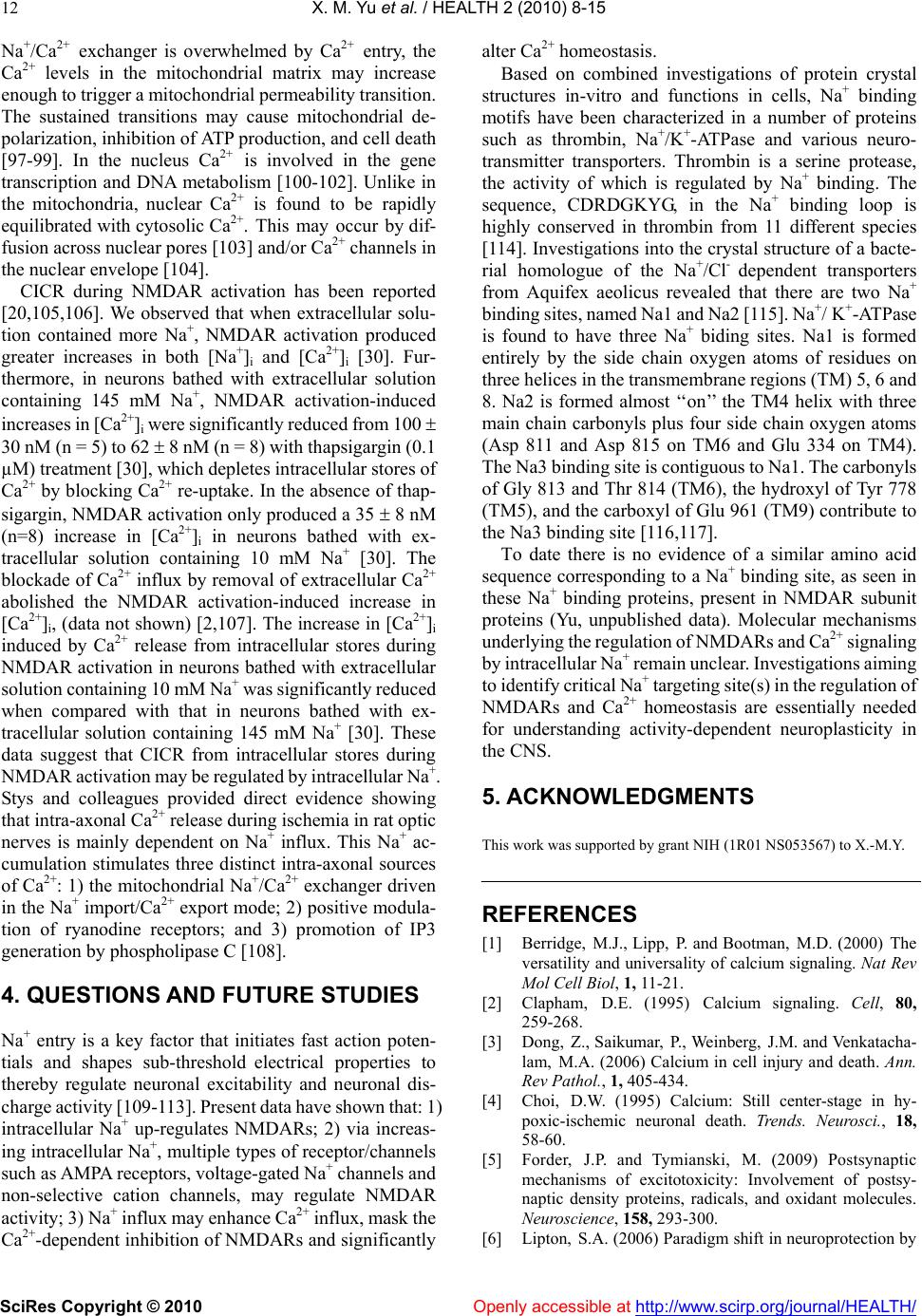 X. M. Yu et al. / HEALTH 2 (2010) 8-15 SciRes Copyright © 2010 Openly accessible at http://www.scirp.org/journal/HEALTH/ 12 Na+/Ca2+ exchanger is overwhelmed by Ca2+ entry, the Ca2+ levels in the mitochondrial matrix may increase enough to trigger a mitochondrial permeability transition. The sustained transitions may cause mitochondrial de- polarization, inhibition of ATP production, and cell death [97-99]. In the nucleus Ca2+ is involved in the gene transcription and DNA metabolism [100-102]. Unlike in the mitochondria, nuclear Ca2+ is found to be rapidly equilibrated with cytosolic Ca2+. This may occur by dif- fusion across nuclear pores [103] and/or Ca2+ channels in the nuclear envelope [104]. CICR during NMDAR activation has been reported [20,105,106]. We observed that when extracellular solu- tion contained more Na+, NMDAR activation produced greater increases in both [Na+]i and [Ca2+]i [30]. Fur- thermore, in neurons bathed with extracellular solution containing 145 mM Na+, NMDAR activation-induced increases in [Ca2+]i were significantly reduced from 100 30 nM (n = 5) to 62 8 nM (n = 8) with thapsigargin (0.1 µM) treatment [30], which depletes intracellular stores of Ca2+ by blocking Ca2+ re-uptake. In the absence of thap- sigargin, NMDAR activation only produced a 35 8 nM (n=8) increase in [Ca2+]i in neurons bathed with ex- tracellular solution containing 10 mM Na+ [30]. The blockade of Ca2+ influx by removal of extracellular Ca2+ abolished the NMDAR activation-induced increase in [Ca2+]i, (data not shown) [2,107]. The increase in [Ca2+]i induced by Ca2+ release from intracellular stores during NMDAR activation in neurons bathed with extracellular solution containing 10 mM Na+ was significantly reduced when compared with that in neurons bathed with ex- tracellular solution containing 145 mM Na+ [30]. These data suggest that CICR from intracellular stores during NMDAR activation may be regulated by intracellular Na+. Stys and colleagues provided direct evidence showing that intra-axonal Ca2+ release during ischemia in rat optic nerves is mainly dependent on Na+ influx. This Na+ ac- cumulation stimulates three distinct intra-axonal sources of Ca2+: 1) the mitochondrial Na+/Ca2+ exchanger driven in the Na+ import/Ca2+ export mode; 2) positive modula- tion of ryanodine receptors; and 3) promotion of IP3 generation by phospholipase C [108]. 4. QUESTIONS AND FUTURE STUDIES Na+ entry is a key factor that initiates fast action poten- tials and shapes sub-threshold electrical properties to thereby regulate neuronal excitability and neuronal dis- charge activity [109-113]. Present data have shown that: 1) intracellular Na+ up-regulates NMDARs; 2) via increas- ing intracellular Na+, multiple types of receptor/channels such as AMPA receptors, voltage-gated Na+ channels and non-selective cation channels, may regulate NMDAR activity; 3) Na+ influx may enhance Ca2+ influx, mask the Ca2+-dependent inhibition of NMDARs and significantly alter Ca2+ homeostasis. Based on combined investigations of protein crystal structures in-vitro and functions in cells, Na+ binding motifs have been characterized in a number of proteins such as thrombin, Na+/K+-ATPase and various neuro- transmitter transporters. Thrombin is a serine protease, the activity of which is regulated by Na+ binding. The sequence, CDRDGKYG, in the Na+ binding loop is highly conserved in thrombin from 11 different species [114]. Investigations into the crystal structure of a bacte- rial homologue of the Na+/Cl- dependent transporters from Aquifex aeolicus revealed that there are two Na+ binding sites, named Na1 and Na2 [115]. Na+/ K+-ATPase is found to have three Na+ biding sites. Na1 is formed entirely by the side chain oxygen atoms of residues on three helices in the transmembrane regions (TM) 5, 6 and 8. Na2 is formed almost ‘‘on’’ the TM4 helix with three main chain carbonyls plus four side chain oxygen atoms (Asp 811 and Asp 815 on TM6 and Glu 334 on TM4). The Na3 binding site is contiguous to Na1. The carbonyls of Gly 813 and Thr 814 (TM6), the hydroxyl of Tyr 778 (TM5), and the carboxyl of Glu 961 (TM9) contribute to the Na3 binding site [116,117]. To date there is no evidence of a similar amino acid sequence corresponding to a Na+ binding site, as seen in these Na+ binding proteins, present in NMDAR subunit proteins (Yu, unpublished data). Molecular mechanisms underlying the regulation of NMDARs and Ca2+ signaling by intracellular Na+ remain unclear. Investigations aiming to identify critical Na+ targeting site(s) in the regulation of NMDARs and Ca2+ homeostasis are essentially needed for understanding activity-dependent neuroplasticity in the CNS. 5. ACKNOWLEDGMENTS This work was supported by grant NIH (1R01 NS053567) to X.-M.Y. REFERENCES [1] Berridge, M.J., Lipp, P. and Bootman, M.D. (2000) The versatility and universality of calcium signaling. Nat Rev Mol Cell Biol, 1, 11-21. [2] Clapham, D.E. (1995) Calcium signaling. Cell, 80, 259-268. [3] Dong, Z., Saikumar, P., Weinberg, J.M. and Venkatacha- lam, M.A. (2006) Calcium in cell injury and death. Ann. Rev Pathol., 1, 405-434. [4] Choi, D.W. (1995) Calcium: Still center-stage in hy- poxic-ischemic neuronal death. Trends. Neurosci., 18, 58-60. [5] Forder, J.P. and Tymianski, M. (2009) Postsynaptic mechanisms of excitotoxicity: Involvement of postsy- naptic density proteins, radicals, and oxidant molecules. Neuroscience, 158, 293-300. [6] Lipton, S.A. (2006) Paradigm shift in neuroprotection by 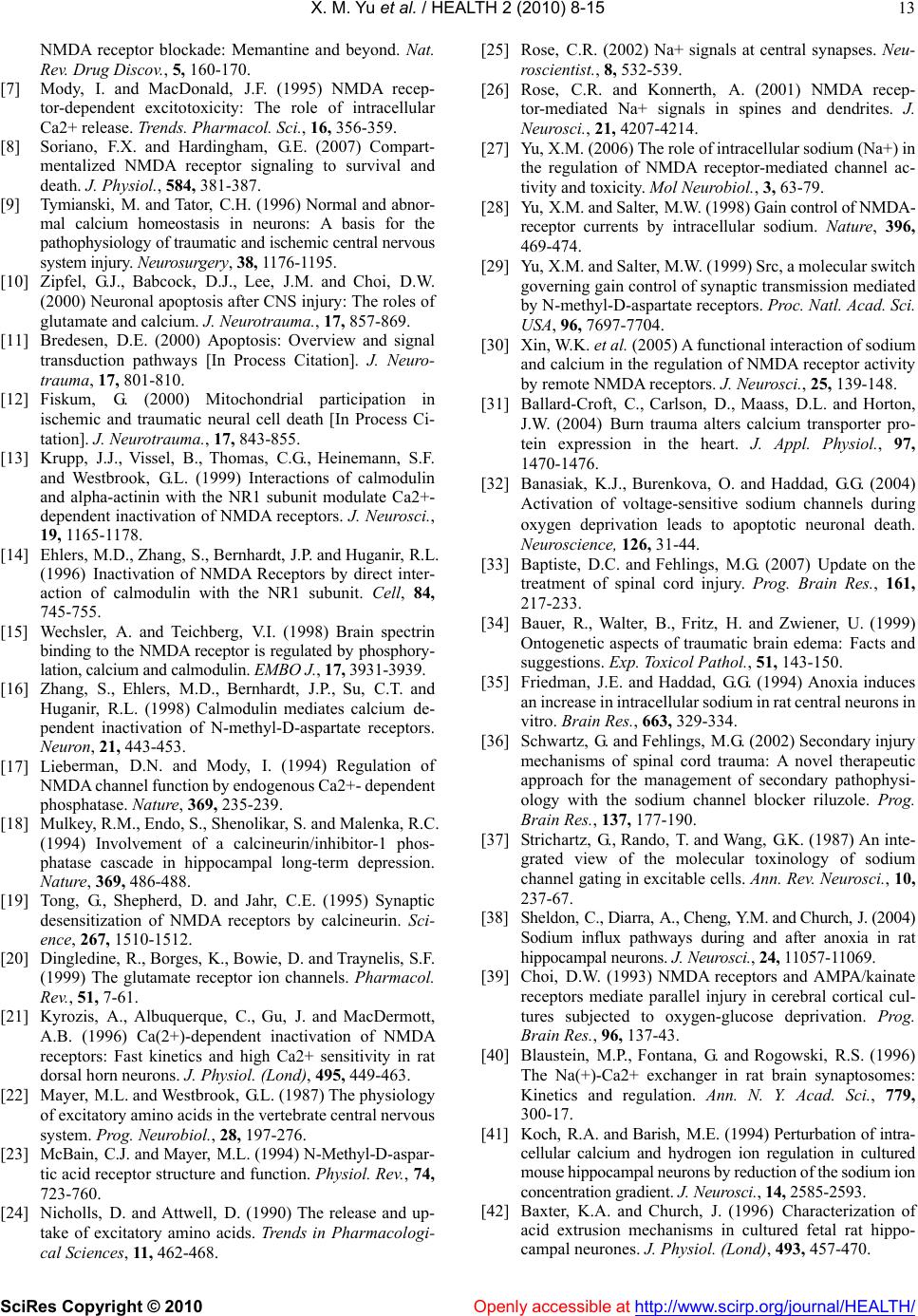 X. M. Yu et al. / HEALTH 2 (2010) 8-15 SciRes Copyright © 2010 Openly accessible at http://www.scirp.org/journal/HEALTH/ 13 NMDA receptor blockade: Memantine and beyond. Nat. Rev. Drug Discov., 5, 160-170. [7] Mody, I. and MacDonald, J.F. (1995) NMDA recep- tor-dependent excitotoxicity: The role of intracellular Ca2+ release. Trends. Pharmacol. Sci., 16, 356-359. [8] Soriano, F.X. and Hardingham, G.E. (2007) Compart- mentalized NMDA receptor signaling to survival and death. J. Physiol., 584, 381-387. [9] Tymianski, M. and Tator, C.H. (1996) Normal and abnor- mal calcium homeostasis in neurons: A basis for the pathophysiology of traumatic and ischemic central nervous system injury. Neurosurgery, 38, 1176-1195. [10] Zipfel, G.J., Babcock, D.J., Lee, J.M. and Choi, D.W. (2000) Neuronal apoptosis after CNS injury: The roles of glutamate and calcium. J. Neurotrauma., 17, 857-869. [11] Bredesen, D.E. (2000) Apoptosis: Overview and signal transduction pathways [In Process Citation]. J. Neuro- trauma, 17, 801-810. [12] Fiskum, G. (2000) Mitochondrial participation in ischemic and traumatic neural cell death [In Process Ci- tation]. J. Neurotrauma., 17, 843-855. [13] Krupp, J.J., Vissel, B., Thomas, C.G., Heinemann, S.F. and Westbrook, G.L. (1999) Interactions of calmodulin and alpha-actinin with the NR1 subunit modulate Ca2+- dependent inactivation of NMDA receptors. J. Neurosci., 19, 1165-1178. [14] Ehlers, M.D., Zhang, S., Bernhardt, J.P. and Huganir, R.L. (1996) Inactivation of NMDA Receptors by direct inter- action of calmodulin with the NR1 subunit. Cell, 84, 745-755. [15] Wechsler, A. and Teichberg, V.I. (1998) Brain spectrin binding to the NMDA receptor is regulated by phosphory- lation, calcium and calmodulin. EMBO J., 17, 3931-3939. [16] Zhang, S., Ehlers, M.D., Bernhardt, J.P., Su, C.T. and Huganir, R.L. (1998) Calmodulin mediates calcium de- pendent inactivation of N-methyl-D-aspartate receptors. Neuron, 21, 443-453. [17] Lieberman, D.N. and Mody, I. (1994) Regulation of NMDA channel function by endogenous Ca2+- dependent phosphatase. Nature, 369, 235-239. [18] Mulkey, R.M., Endo, S., Shenolikar, S. and Malenka, R.C. (1994) Involvement of a calcineurin/inhibitor-1 phos- phatase cascade in hippocampal long-term depression. Nature, 369, 486-488. [19] Tong, G., Shepherd, D. and Jahr, C.E. (1995) Synaptic desensitization of NMDA receptors by calcineurin. Sci- ence, 267, 1510-1512. [20] Dingledine, R., Borges, K., Bowie, D. and Traynelis, S.F. (1999) The glutamate receptor ion channels. Pharmacol. Rev., 51, 7-61. [21] Kyrozis, A., Albuquerque, C., Gu, J. and MacDermott, A.B. (1996) Ca(2+)-dependent inactivation of NMDA receptors: Fast kinetics and high Ca2+ sensitivity in rat dorsal horn neurons. J. Physiol. (Lond), 495, 449-463. [22] Mayer, M.L. and Westbrook, G.L. (1987) The physiology of excitatory amino acids in the vertebrate central nervous system. Prog. Neurobiol., 28, 197-276. [23] McBain, C.J. and Mayer, M.L. (1994) N-Methyl-D-aspar- tic acid receptor structure and function. Physiol. Rev., 74, 723-760. [24] Nicholls, D. and Attwell, D. (1990) The release and up- take of excitatory amino acids. Trends in Pharmacologi- cal Sciences, 11, 462-468. [25] Rose, C.R. (2002) Na+ signals at central synapses. Neu- roscientist., 8, 532-539. [26] Rose, C.R. and Konnerth, A. (2001) NMDA recep- tor-mediated Na+ signals in spines and dendrites. J. Neurosci., 21, 4207-4214. [27] Yu, X.M. (2006) The role of intracellular sodium (Na+) in the regulation of NMDA receptor-mediated channel ac- tivity and toxicity. Mol Neurobiol., 3, 63-79. [28] Yu, X.M. and Salter, M.W. (1998) Gain control of NMDA- receptor currents by intracellular sodium. Nature, 396, 469-474. [29] Yu, X.M. and Salter, M.W. (1999) Src, a molecular switch governing gain control of synaptic transmission mediated by N-methyl-D-aspartate receptors. Proc. Natl. Acad. Sci. USA, 96, 7697-7704. [30] Xin, W.K. et al. (2005) A functional interaction of sodium and calcium in the regulation of NMDA receptor activity by remote NMDA receptors. J. Neurosci., 25, 139-148. [31] Ballard-Croft, C., Carlson, D., Maass, D.L. and Horton, J.W. (2004) Burn trauma alters calcium transporter pro- tein expression in the heart. J. Appl. Physiol., 97, 1470-1476. [32] Banasiak, K.J., Burenkova, O. and Haddad, G.G. (2004) Activation of voltage-sensitive sodium channels during oxygen deprivation leads to apoptotic neuronal death. Neuroscience, 126, 31-44. [33] Baptiste, D.C. and Fehlings, M.G. (2007) Update on the treatment of spinal cord injury. Prog. Brain Res., 161, 217-233. [34] Bauer, R., Walter, B., Fritz, H. and Zwiener, U. (1999) Ontogenetic aspects of traumatic brain edema: Facts and suggestions. Exp. Toxicol Pathol., 51, 143-150. [35] Friedman, J.E. and Haddad, G.G. (1994) Anoxia induces an increase in intracellular sodium in rat central neurons in vitro. Brain Res., 663, 329-334. [36] Schwartz, G. and Fehlings, M.G. (2002) Secondary injury mechanisms of spinal cord trauma: A novel therapeutic approach for the management of secondary pathophysi- ology with the sodium channel blocker riluzole. Prog. Brain Res., 137, 177-190. [37] Strichartz, G., Rando, T. and Wang, G.K. (1987) An inte- grated view of the molecular toxinology of sodium channel gating in excitable cells. Ann. Rev. Neurosci., 10, 237-67. [38] Sheldon, C., Diarra, A., Cheng, Y.M. and Church, J. (2004) Sodium influx pathways during and after anoxia in rat hippocampal neurons. J. Neurosci., 24, 11057-11069. [39] Choi, D.W. (1993) NMDA receptors and AMPA/kainate receptors mediate parallel injury in cerebral cortical cul- tures subjected to oxygen-glucose deprivation. Prog. Brain Res., 96, 137-43. [40] Blaustein, M.P., Fontana, G. and Rogowski, R.S. (1996) The Na(+)-Ca2+ exchanger in rat brain synaptosomes: Kinetics and regulation. Ann. N. Y. Acad. Sci., 779, 300-17. [41] Koch, R.A. and Barish, M.E. (1994) Perturbation of intra- cellular calcium and hydrogen ion regulation in cultured mouse hippocampal neurons by reduction of the sodium ion concentration gradient. J. Neurosci., 14, 2585-2593. [42] Baxter, K.A. and Church, J. (1996) Characterization of acid extrusion mechanisms in cultured fetal rat hippo- campal neurones. J. Physiol. (Lond), 493, 457-470. 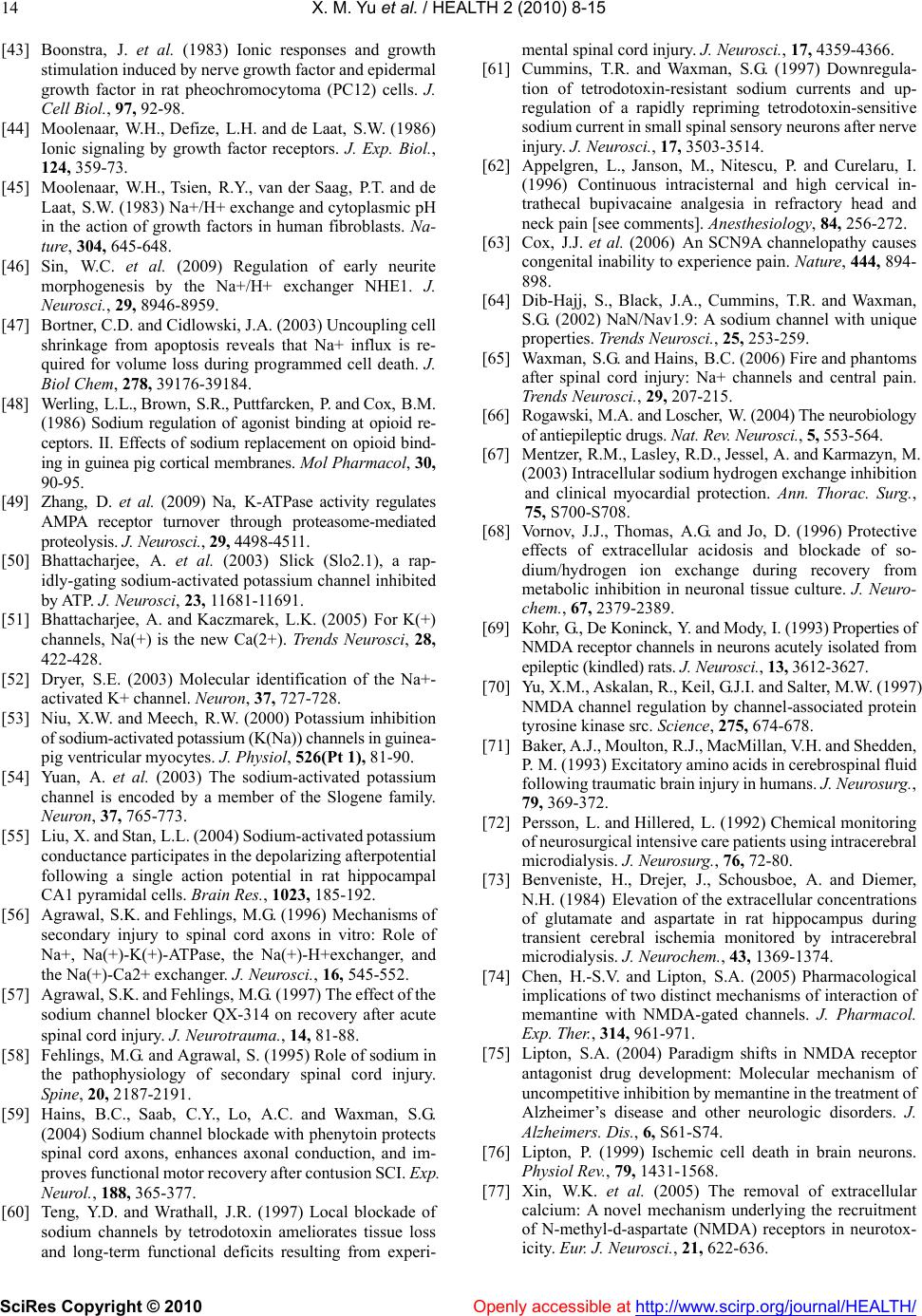 X. M. Yu et al. / HEALTH 2 (2010) 8-15 SciRes Copyright © 2010 Openly accessible at http://www.scirp.org/journal/HEALTH/ 14 [43] Boonstra, J. et al. (1983) Ionic responses and growth stimulation induced by nerve growth factor and epidermal growth factor in rat pheochromocytoma (PC12) cells. J. Cell Biol., 97, 92-98. [44] Moolenaar, W.H., Defize, L.H. and de Laat, S.W. (1986) Ionic signaling by growth factor receptors. J. Exp. Biol., 124, 359-73. [45] Moolenaar, W.H., Tsien, R.Y., van der Saag, P.T. and de Laat, S.W. (1983) Na+/H+ exchange and cytoplasmic pH in the action of growth factors in human fibroblasts. Na- ture, 304, 645-648. [46] Sin, W.C. et al. (2009) Regulation of early neurite morphogenesis by the Na+/H+ exchanger NHE1. J. Neurosci., 29, 8946-8959. [47] Bortner, C.D. and Cidlowski, J.A. (2003) Uncoupling cell shrinkage from apoptosis reveals that Na+ influx is re- quired for volume loss during programmed cell death. J. Biol Chem, 278, 39176-39184. [48] Werling, L.L., Brown, S.R., Puttfarcken, P. and Cox, B.M. (1986) Sodium regulation of agonist binding at opioid re- ceptors. II. Effects of sodium replacement on opioid bind- ing in guinea pig cortical membranes. Mol Pharmacol, 30, 90-95. [49] Zhang, D. et al. (2009) Na, K-ATPase activity regulates AMPA receptor turnover through proteasome-mediated proteolysis. J. Neurosci., 29, 4498-4511. [50] Bhattacharjee, A. et al. (2003) Slick (Slo2.1), a rap- idly-gating sodium-activated potassium channel inhibited by ATP. J. Neurosci, 23, 11681-11691. [51] Bhattacharjee, A. and Kaczmarek, L.K. (2005) For K(+) channels, Na(+) is the new Ca(2+). Trends Neurosci, 28, 422-428. [52] Dryer, S.E. (2003) Molecular identification of the Na+- activated K+ channel. Neuron, 37, 727-728. [53] Niu, X.W. and Meech, R.W. (2000) Potassium inhibition of sodium-activated potassium (K(Na)) channels in guinea- pig ventricular myocytes. J. Physiol, 526(Pt 1), 81-90. [54] Yuan, A. et al. (2003) The sodium-activated potassium channel is encoded by a member of the Slogene family. Neuron, 37, 765-773. [55] Liu, X. and Stan, L.L. (2004) Sodium-activated potassium conductance participates in the depolarizing afterpotential following a single action potential in rat hippocampal CA1 pyramidal cells. Brain Res., 1023, 185-192. [56] Agrawal, S.K. and Fehlings, M.G. (1996) Mechanisms of secondary injury to spinal cord axons in vitro: Role of Na+, Na(+)-K(+)-ATPase, the Na(+)-H+exchanger, and the Na(+)-Ca2+ exchanger. J. Neurosci., 16, 545-552. [57] Agrawal, S.K. and Fehlings, M.G. (1997) The effect of the sodium channel blocker QX-314 on recovery after acute spinal cord injury. J. Neurotrauma., 14, 81-88. [58] Fehlings, M.G. and Agrawal, S. (1995) Role of sodium in the pathophysiology of secondary spinal cord injury. Spine, 20, 2187-2191. [59] Hains, B.C., Saab, C.Y., Lo, A.C. and Waxman, S.G. (2004) Sodium channel blockade with phenytoin protects spinal cord axons, enhances axonal conduction, and im- proves functional motor recovery after contusion SCI. Exp. Neurol., 188, 365-377. [60] Teng, Y.D. and Wrathall, J.R. (1997) Local blockade of sodium channels by tetrodotoxin ameliorates tissue loss and long-term functional deficits resulting from experi- mental spinal cord injury. J. Neurosci., 17, 4359-4366. [61] Cummins, T.R. and Waxman, S.G. (1997) Downregula- tion of tetrodotoxin-resistant sodium currents and up- regulation of a rapidly repriming tetrodotoxin-sensitive sodium current in small spinal sensory neurons after nerve injury. J. Neurosci., 17, 3503-3514. [62] Appelgren, L., Janson, M., Nitescu, P. and Curelaru, I. (1996) Continuous intracisternal and high cervical in- trathecal bupivacaine analgesia in refractory head and neck pain [see comments]. Anesthesiology, 84, 256-272. [63] Cox, J.J. et al. (2006) An SCN9A channelopathy causes congenital inability to experience pain. Nature, 444, 894- 898. [64] Dib-Hajj, S., Black, J.A., Cummins, T.R. and Waxman, S.G. (2002) NaN/Nav1.9: A sodium channel with unique properties. Trends Neurosci., 25, 253-259. [65] Waxman, S.G. and Hains, B.C. (2006) Fire and phantoms after spinal cord injury: Na+ channels and central pain. Trends Neurosci., 29, 207-215. [66] Rogawski, M.A. and Loscher, W. (2004) The neurobiology of antiepileptic drugs. Nat. Rev. Neurosci., 5, 553-564. [67] Mentzer, R.M., Lasley, R.D., Jessel, A. and Karmazyn, M. (2003) Intracellular sodium hydrogen exchange inhibition and clinical myocardial protection. Ann. Thorac. Surg., 75, S700-S708. [68] Vornov, J.J., Thomas, A.G. and Jo, D. (1996) Protective effects of extracellular acidosis and blockade of so- dium/hydrogen ion exchange during recovery from metabolic inhibition in neuronal tissue culture. J. Neuro- chem., 67, 2379-2389. [69] Kohr, G., De Koninck, Y. and Mody, I. (1993) Properties of NMDA receptor channels in neurons acutely isolated from epileptic (kindled) rats. J. Neurosci., 13, 3612-3627. [70] Yu, X.M., Askalan, R., Keil, G.J.I. and Salter, M.W. (1997) NMDA channel regulation by channel-associated protein tyrosine kinase src. Science, 275, 674-678. [71] Baker, A.J., Moulton, R.J., MacMillan, V.H. and Shedden, P. M. (1993) Excitatory amino acids in cerebrospinal fluid following traumatic brain injury in humans. J. Neurosurg., 79, 369-372. [72] Persson, L. and Hillered, L. (1992) Chemical monitoring of neurosurgical intensive care patients using intracerebral microdialysis. J. Neurosurg., 76, 72-80. [73] Benveniste, H., Drejer, J., Schousboe, A. and Diemer, N.H. (1984) Elevation of the extracellular concentrations of glutamate and aspartate in rat hippocampus during transient cerebral ischemia monitored by intracerebral microdialysis. J. Neurochem., 43, 1369-1374. [74] Chen, H.-S.V. and Lipton, S.A. (2005) Pharmacological implications of two distinct mechanisms of interaction of memantine with NMDA-gated channels. J. Pharmacol. Exp. Ther., 314, 961-971. [75] Lipton, S.A. (2004) Paradigm shifts in NMDA receptor antagonist drug development: Molecular mechanism of uncompetitive inhibition by memantine in the treatment of Alzheimer’s disease and other neurologic disorders. J. Alzheimers. Dis., 6, S61-S74. [76] Lipton, P. (1999) Ischemic cell death in brain neurons. Physiol Rev., 79, 1431-1568. [77] Xin, W.K. et al. (2005) The removal of extracellular calcium: A novel mechanism underlying the recruitment of N-methyl-d-aspartate (NMDA) receptors in neurotox- icity. Eur. J. Neurosci., 21, 622-636. 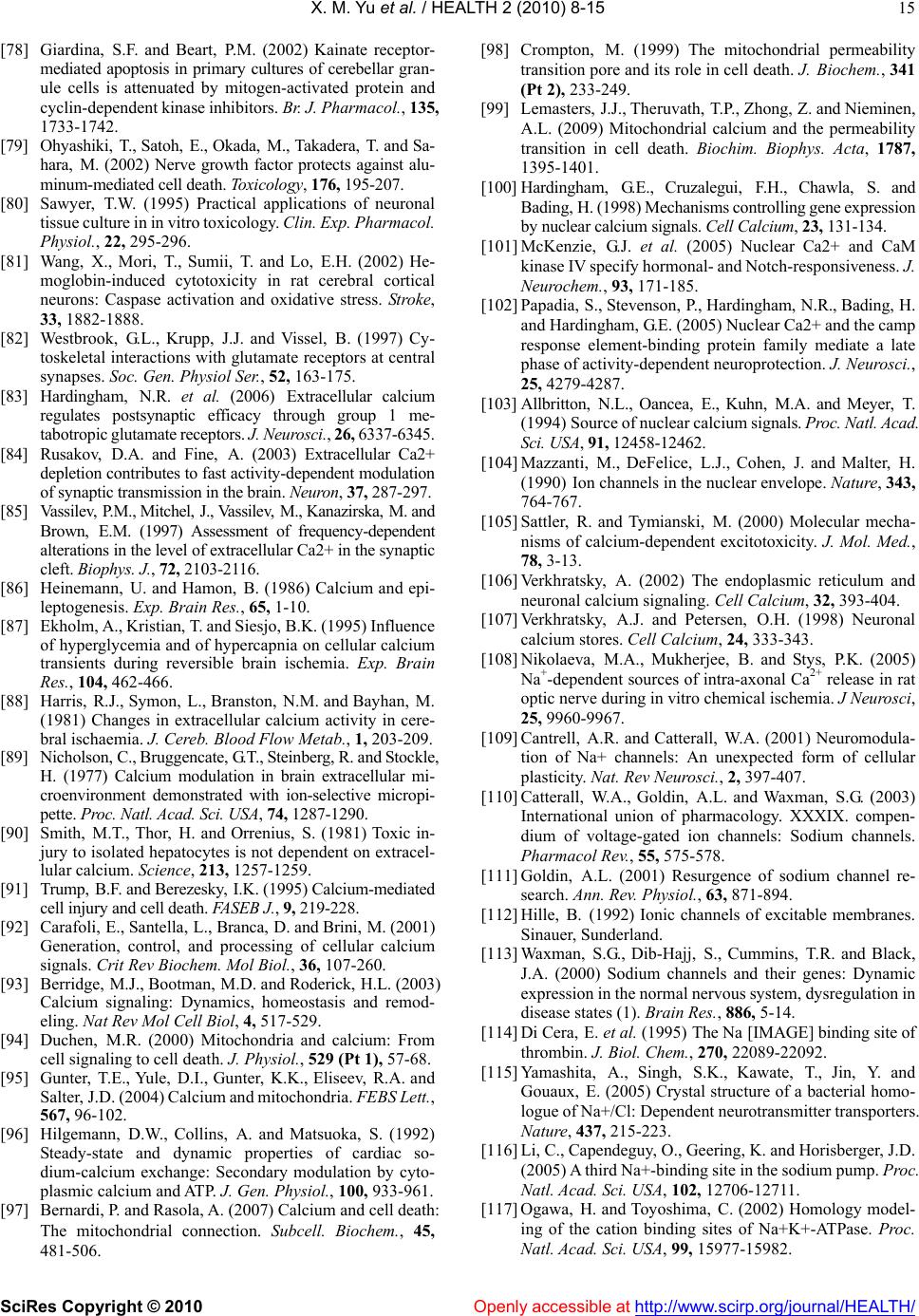 X. M. Yu et al. / HEALTH 2 (2010) 8-15 SciRes Copyright © 2010 http://www.scirp.org/journal/HEALTH/ Openly accessible at 15 [78] Giardina, S.F. and Beart, P.M. (2002) Kainate receptor- mediated apoptosis in primary cultures of cerebellar gran- ule cells is attenuated by mitogen-activated protein and cyclin-dependent kinase inhibitors. Br. J. Pharmacol., 135, 1733-1742. [79] Ohyashiki, T., Satoh, E., Okada, M., Takadera, T. and Sa- hara, M. (2002) Nerve growth factor protects against alu- minum-mediated cell death. Toxicology, 176, 195-207. [80] Sawyer, T.W. (1995) Practical applications of neuronal tissue culture in in vitro toxicology. Clin. Exp. Pharmacol. Physiol., 22, 295-296. [81] Wang, X., Mori, T., Sumii, T. and Lo, E.H. (2002) He- moglobin-induced cytotoxicity in rat cerebral cortical neurons: Caspase activation and oxidative stress. St ro k e , 33, 1882-1888. [82] Westbrook, G.L., Krupp, J.J. and Vissel, B. (1997) Cy- toskeletal interactions with glutamate receptors at central synapses. Soc. Gen. Physiol Ser., 52, 163-175. [83] Hardingham, N.R. et al. (2006) Extracellular calcium regulates postsynaptic efficacy through group 1 me- tabotropic glutamate receptors. J. Neurosci., 26, 6337-6345. [84] Rusakov, D.A. and Fine, A. (2003) Extracellular Ca2+ depletion contributes to fast activity-dependent modulation of synaptic transmission in the brain. Neuron, 37, 287-297. [85] Vassilev, P.M., Mitchel, J., Vassilev, M., Kanazirska, M. and Brown, E.M. (1997) Assessment of frequency-dependent alterations in the level of extracellular Ca2+ in the synaptic cleft. Biophys. J., 72, 2103-2116. [86] Heinemann, U. and Hamon, B. (1986) Calcium and epi- leptogenesis. Exp. Brain Res., 65, 1-10. [87] Ekholm, A., Kristian, T. and Siesjo, B.K. (1995) Influence of hyperglycemia and of hypercapnia on cellular calcium transients during reversible brain ischemia. Exp. Brain Res., 104, 462-466. [88] Harris, R.J., Symon, L., Branston, N.M. and Bayhan, M. (1981) Changes in extracellular calcium activity in cere- bral ischaemia. J. Cereb. Blood Flow Metab., 1, 203-209. [89] Nicholson, C., Bruggencate, G.T., Steinberg, R. and Stockle, H. (1977) Calcium modulation in brain extracellular mi- croenvironment demonstrated with ion-selective micropi- pette. Proc. Natl. Acad. Sci. USA, 74, 1287-1290. [90] Smith, M.T., Thor, H. and Orrenius, S. (1981) Toxic in- jury to isolated hepatocytes is not dependent on extracel- lular calcium. Science, 213, 1257-1259. [91] Trump, B.F. and Berezesky, I.K. (1995) Calcium-mediated cell injury and cell death. FASEB J., 9, 219-228. [92] Carafoli, E., Santella, L., Branca, D. and Brini, M. (2001) Generation, control, and processing of cellular calcium signals. Crit Rev Biochem. Mol Biol., 36, 107-260. [93] Berridge, M.J., Bootman, M.D. and Roderick, H.L. (2003) Calcium signaling: Dynamics, homeostasis and remod- eling. Nat Rev Mol Cell Biol, 4, 517-529. [94] Duchen, M.R. (2000) Mitochondria and calcium: From cell signaling to cell death. J. Physiol., 529 (Pt 1), 57-68. [95] Gunter, T.E., Yule, D.I., Gunter, K.K., Eliseev, R.A. and Salter, J.D. (2004) Calcium and mitochondria. FEBS Lett., 567, 96-102. [96] Hilgemann, D.W., Collins, A. and Matsuoka, S. (1992) Steady-state and dynamic properties of cardiac so- dium-calcium exchange: Secondary modulation by cyto- plasmic calcium and ATP. J. Gen. Physiol., 100, 933-961. [97] Bernardi, P. and Rasola, A. (2007) Calcium and cell death: The mitochondrial connection. Subcell. Biochem., 45, 481-506. [98] Crompton, M. (1999) The mitochondrial permeability transition pore and its role in cell death. J. Biochem., 341 (Pt 2), 233-249. [99] Lemasters, J.J., Theruvath, T.P., Zhong, Z. and Nieminen, A.L. (2009) Mitochondrial calcium and the permeability transition in cell death. Biochim. Biophys. Acta, 1787, 1395-1401. [100] Hardingham, G.E., Cruzalegui, F.H., Chawla, S. and Bading, H. (1998) Mechanisms controlling gene expression by nuclear calcium signals. Cell Calcium, 23, 131-134. [101] McKenzie, G.J. et al. (2005) Nuclear Ca2+ and CaM kinase IV specify hormonal- and Notch-responsiveness. J. Neurochem., 93, 171-185. [102] Papadia, S., Stevenson, P., Hardingham, N.R., Bading, H. and Hardingham, G.E. (2005) Nuclear Ca2+ and the camp response element-binding protein family mediate a late phase of activity-dependent neuroprotection. J. Neurosci., 25, 4279-4287. [103] Allbritton, N.L., Oancea, E., Kuhn, M.A. and Meyer, T. (1994) Source of nuclear calcium signals. Proc. Natl. Acad. Sci. USA, 91, 12458-12462. [104] Mazzanti, M., DeFelice, L.J., Cohen, J. and Malter, H. (1990) Ion channels in the nuclear envelope. Nature, 343, 764-767. [105] Sattler, R. and Tymianski, M. (2000) Molecular mecha- nisms of calcium-dependent excitotoxicity. J. Mol. Med., 78, 3-13. [106] Verkhratsky, A. (2002) The endoplasmic reticulum and neuronal calcium signaling. Cell Calcium, 32, 393-404. [107] Verkhratsky, A.J. and Petersen, O.H. (1998) Neuronal calcium stores. Cell Calcium, 24, 333-343. [108] Nikolaeva, M.A., Mukherjee, B. and Stys, P.K. (2005) Na+-dependent sources of intra-axonal Ca2+ release in rat optic nerve during in vitro chemical ischemia. J Neurosci, 25, 9960-9967. [109] Cantrell, A.R. and Catterall, W.A. (2001) Neuromodula- tion of Na+ channels: An unexpected form of cellular plasticity. Nat. Rev Neurosci., 2, 397-407. [110] Catterall, W.A., Goldin, A.L. and Waxman, S.G. (2003) International union of pharmacology. XXXIX. compen- dium of voltage-gated ion channels: Sodium channels. Pharmacol Rev., 55, 575-578. [111] Goldin, A.L. (2001) Resurgence of sodium channel re- search. Ann. Rev. Physiol., 63, 871-894. [112] Hille, B. (1992) Ionic channels of excitable membranes. Sinauer, Sunderland. [113] Waxman, S.G., Dib-Hajj, S., Cummins, T.R. and Black, J.A. (2000) Sodium channels and their genes: Dynamic expression in the normal nervous system, dysregulation in disease states (1). Brain Res., 886, 5-14. [114] Di Cera, E. et al. (1995) The Na [IMAGE] binding site of thrombin. J. Biol. Chem., 270, 22089-22092. [115] Yamashita, A., Singh, S.K., Kawate, T., Jin, Y. and Gouaux, E. (2005) Crystal structure of a bacterial homo- logue of Na+/Cl: Dependent neurotransmitter transporters. Nature, 437, 215-223. [116] Li, C., Capendeguy, O., Geering, K. and Horisberger, J.D. (2005) A third Na+-binding site in the sodium pump. Proc. Natl. Acad. Sci. USA, 102, 12706-12711. [117] Ogawa, H. and Toyoshima, C. (2002) Homology model- ing of the cation binding sites of Na+K+-ATPase. Proc. Natl. Acad. Sci. USA, 99, 15977-15982. |

